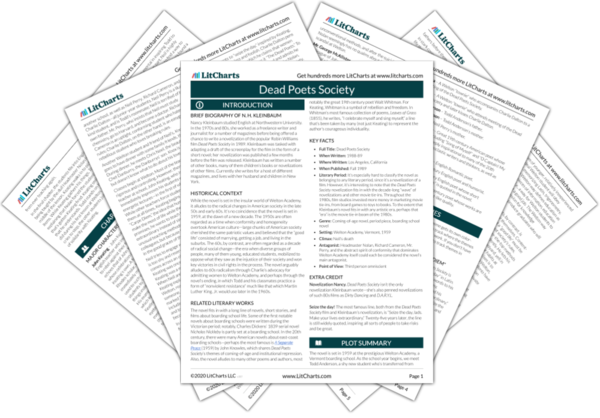Life, Death, and “Carpe Diem”
The most famous quote in Dead Poets Society is “carpe diem,” which means “seize the day” in Latin. Professor John Keating delivers these words to his students on the first day of school at Welton Academy, symbolizing his unorthodox approach to education and his desire to inspire his students to “make their lives extraordinary.” It’s important to understand what Keating means by “seize the day,” what kinds of lives Keating wants his students to live…
read analysis of Life, Death, and “Carpe Diem”Education
As its boarding school setting would suggest, Dead Poets Society is in large part a novel about education. The book articulates two competing theories about how young people should be educated: first, the process of rote memorization and blind obedience practiced by most teachers at Welton Academy (the “Welton way”); second, the process of training students to think for themselves (the “Keating way”).
At Welton, students are trained to obey authorities and internalize whatever knowledge…
read analysis of EducationConformity and Success
The first scene of the novel conveys the preeminence of conformity at Welton Academy: Welton’s students dutifully file into the chapel, dressed in the same school blazers and reciting the same “four pillars” of success at Welton (tradition, honor, discipline, excellence). In a way, conformity—the blind emphasis on sameness and repetition—is the real villain of Dead Poets Society. It’s important to understand where conformity comes from and why it has the potential to be…
read analysis of Conformity and Success
Rebellion and Passion
Faced with the crushing conformity of boarding school life, John Keating inspires many of his students to rebel against the repressive, sometimes tyrannical culture at Welton Academy. The students’ rebellion takes many different forms, some internal (“freeing their minds” from conformity) and some external (drinking, sneaking off campus, playing pranks, etc.). At the end of the novel, we see an extreme form of rebellion against conformity and repressiveness: Neil Perry’s tragic suicide. In general…
read analysis of Rebellion and PassionMen, Women, and Love
Dead Poets Society is set at Welton Academy, an all-boys school. Furthermore, it takes place from 1959 to 1960—an era when the feminist movement was causing big changes in American society. So it’s no surprise that the novel has a lot to say about the relationships between men and women—in particular, between young men and young women.
Almost without exception, the relationships between men and women that Dead Poets Society depicts are romantic in nature…
read analysis of Men, Women, and Love






